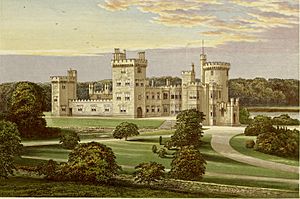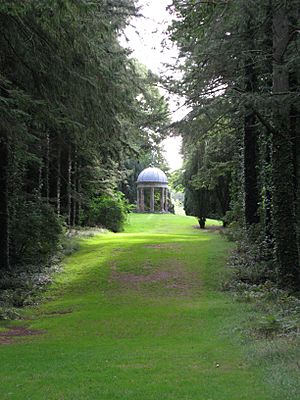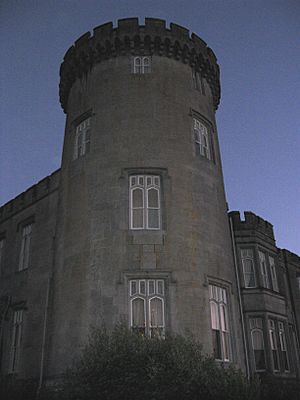Dromoland Castle facts for kids
Quick facts for kids Dromoland Castle |
|
|---|---|

Entrance to Dromoland Castle
|
|
| General information | |
| Status | Luxury hotel |
| Type | castle |
| Architectural style | Gothic Revival |
| Location | County Clare |
| Country | Ireland |
| Estimated completion | 15th/16th century (original) 1835 (current structure) |
| Design and construction | |
| Architect | James and George Richard Pain (current structure) |
| Dromoland Castle | |
|---|---|
| Restaurant information | |
| Head chef | Jean Baptiste Molinari |
| Rating | |
| City | Newmarket-on-Fergus |
| Country | Ireland |
Dromoland Castle (Irish: Drom Ólainn) is a castle, located near Newmarket-on-Fergus in County Clare, Ireland. It is operated as a 5-star luxury hotel with a golf course, with its restaurant, the Earl of Thomond, being awarded a Michelin star in 1995, under head chef Jean Baptiste Molinari.
The present building was completed in 1835. However, the first building constructed here seems to have been a tower house built in the 15th or early 16th century and is recorded as being erected by Thomas, the son of Shane Mac Anerheny. There were at least three houses on the site, at various times, called Dromoland. While Dromoland later became residence of eight generations of the O'Brien family, early records suggest that the area was also occupied by other local Gaelic families, such as the McInerney family during the 16th century. According to the historian James Frost, Dromoland translates as the "Hill of Litigation".
Contents
History
In 1551 Dromoland was listed in the will of Murrough O'Brien. He was first Tanist and in 1543 had been granted the title of first Earl of Thomond by Henry VIII. Murrough bequeathed Leamaneh Castle to his third son Donough MacMurrough O'Brien, and also gave him the castle and lands at Dromoland. In 1582 Donough was hanged in Limerick on charges of rebellion and the government decided that all his property would be forfeited to the Crown. Accordingly, Sir George Cusack, the sheriff, took possession of Dromoland. Some years later, Turlough O'Brien killed Cusack and various O'Briens attempted to re-possess Dromoland. The fourth Earl of Thomond claimed to have sole ownership and tried to exclude Donough's son, Conor MacDonough O'Brien. The outcome of this dispute is unclear.
In 1604 when Conor O'Brien died he left Dromoland to his son, Donough MacConor O'Brien. Donough, whose mother was Slany O'Brien, was then only about eight years old. A legal battle ensued between the fourth Earl and Slany O'Brien. The dispute was settled by arbitration in 1613. The Earl, by now Lord Thomond, became owner of Dromoland on payment of 132.13.4 pounds in compensation to Slany O'Brien. When Donough was older, he refused to abide by the settlement. By 1614 a William Starkey was leasing Dromoland from Lord Thomond. By 1628 Lord Thomond was dead and Donough continued the dispute through the Court of Wards and Liveries in Dublin. In 1629 Donough was granted entry "on all the manors, lands and tenements of his late father" on payment of a fine. Dromoland was however not listed among the many properties named, and it rested with the Earls of Thomond for another fifty years. The fifth Earl did transfer two other properties to Donough as compensation.
Robert Starkey, son of William, was in residence at Dromoland when the rebellion of 1641 began. It seems that he either fled the area or sublet the property. In 1642 Col. Conor O'Brien of Leamaneh, son of Donough and husband of Maire Rua, seized the castle along with a Captain McInerhenny, the leader of the Irish force, who surprised the guards through help of Starkey's assistant Moran. Conor was killed in battle in 1651. His eldest son Donough O'Brien, born to Conor and Máire Rua O'Brien in 1642, was heir to Leamaneh Castle and to the family claim on Dromoland. In addition, Donough inherited large landholdings from his half-brother, William O'Neylan (O'Neillan) (1635–78) of Dysert O'Dea Castle, to whose father Daniel Máire Rua had been married from 1634 until his death in 1639.
Robert Starkey resumed the lease and in 1666 Dromoland was sub-leased to Colonel Daniel O'Brien from Carrigaholt Castle. Three years later, it was assigned to Thomas Walcott of Moyhill. Finally, in 1684 the freehold was assigned to Donough O'Brien. At this time Dromoland was a modest house. The original tower house seems to have been added onto during Starkey's time, before Donough moved in from Leamaneh.
Sir Donough O'Brien, 1st Baronet, died in 1717. During his time at Dromoland, it was described as "a handsome Grecian Building." Donough's son Lucius also died in 1717 so Edward, son of Lucius, became 2nd Baronet. This first Sir Edward O'Brien decorated the house with pictures and carvings. He also had designs drawn up for a new house. Thomas Roberts and John Aheron both submitted drawings to him for a house and garden at Dromoland. John Aheron appears to have been the architect responsible for the final design. He also designed the Gazebo on Turret Hill, across the road from the main entrance gateway. It was probably built for observing the training of horses. Dromoland was expanded to a ten-bay, 2+1⁄2-storey house. A two-story quadrangle was completed in 1736. Edward died in 1765.
In 1795 an issue of the Gentleman's Magazine gave the following description of Dromoland:
"the noble and beautiful seat of Sir Lucius O'Brien, Bart., in the county of Clare, situated on a hill gently rising from a lake of twenty four acres in the middle of woods. Three beautiful hills rise above it, commanding fine prospects of the great rivers Fergus and Shannon at their junction, being each of them a league wide."
Sir Lucius O'Brien was the eldest son of the first Sir Edward and was the 3rd Baronet. He died in 1794. His son, the second Sir Edward, was the 4th Baronet, and decided to rebuild the castle. In 1821, it was the birthplace of Edward's brother Robert's son, George O'Brien. Work began around 1822 and cost about Ј50,000 to complete. The Pain brothers submitted some classical designs but Edward O'Brien chose their neo-gothic designs, influenced by John Nash. James and George Richard Pain had been pupils of Nash in England. The building was completed in 1835. Samuel Lewis writing in 1837 described Dromoland as:
"a superb edifice in the castellated style, lately erected on the site of the ancient mansion, and surrounded by an extensive and richly wooded demesne, in which great improvements have recently been made".
Edward was married to Charlotte Smith and her inherited wealth was probably essential in covering construction costs of their new mansion. Edward and Charlotte were parents of William Smith O'Brien, the leader of the Young Irelander rebellion of 1848. Sir Edward died in 1837. His eldest son Lucius was 5th Baronet and 13th Baron Inchiquin.
Burke's Visitation of Seats (1855) gives the following description of Dromoland:
"It is built entirely of dark blue limestone, and in fine chiseled workmanship; the ornamental grounds and woods extend over more than 1,500 [6.1 km2] of land…from some of the eminences there are views of the Shannon and Fergus, which, at this part of the country, resembles a large inland lake with island, making Dromoland one of the most beautiful and desirable residences in Ireland."
Modern form
Dromoland has been preserved with little change since the mid-19th century. The mansion is in "baronial" or "Gothic Revival" style. It has four linked irregular castellated turrets. A gothic porch to the north front displays the O'Brien arms. The western portion faces out to the lake, and the east towards the hill where Thomond House now stands. The large walled gardens are to the south. In 1902 the 15th Baron Inchiquin, Lucius, took the old 17th century gateway from Leamaneh and erected it at the entrance to the large walled garden. A long curving drive leads from the gateway and classical lodge, passing north of the lake and round to the front door of the castle.
In 1962, Donough O'Brien, the sixteenth Baron Inchiquin, sold Dromoland Castle and 350 acres (1.4 km2) because of difficult financial circumstances. He built Thomond House on a hill overlooking Dromoland. He moved into this Georgian style house in 1965 and died in 1968. The house is now occupied by the 18th Baron Inchiquin.
Hotel
Dromoland Castle was bought by United States citizen Bernard P. McDonough in 1962. It has since then been converted for use as a top-grade luxurious hotel.
Dromoland Castle Hotel is a member of Historic Hotels Worldwide.
Famous guests

United States President George W. Bush spent the night of Friday, 26 June 2004, at Dromoland Castle to attend the EU-US Summit held at the facility. President Bush was guarded by approximately 7,000 police, military and private security forces during his 16-hour visit.
Over the years, the guests to have stayed at Dromoland Castle have included Bill Clinton, Juan Carlos I of Spain, Nelson Mandela, Muhammad Ali, Richard Branson, Jack Nicholson, Johnny Cash, Michael Flatley, Bono and John Travolta.




